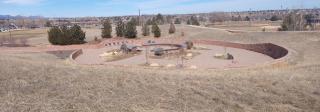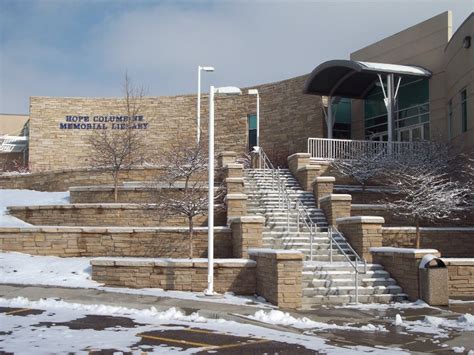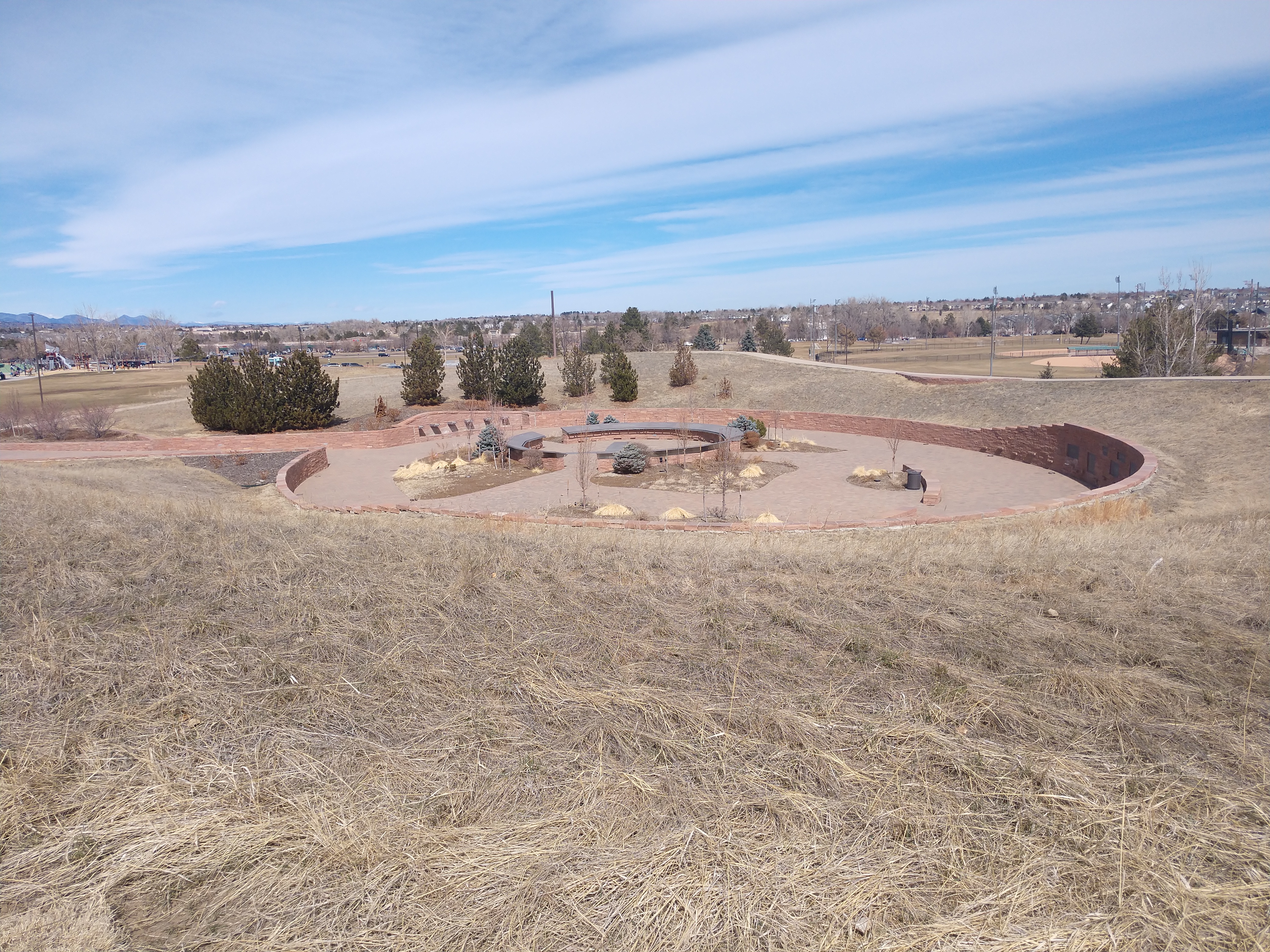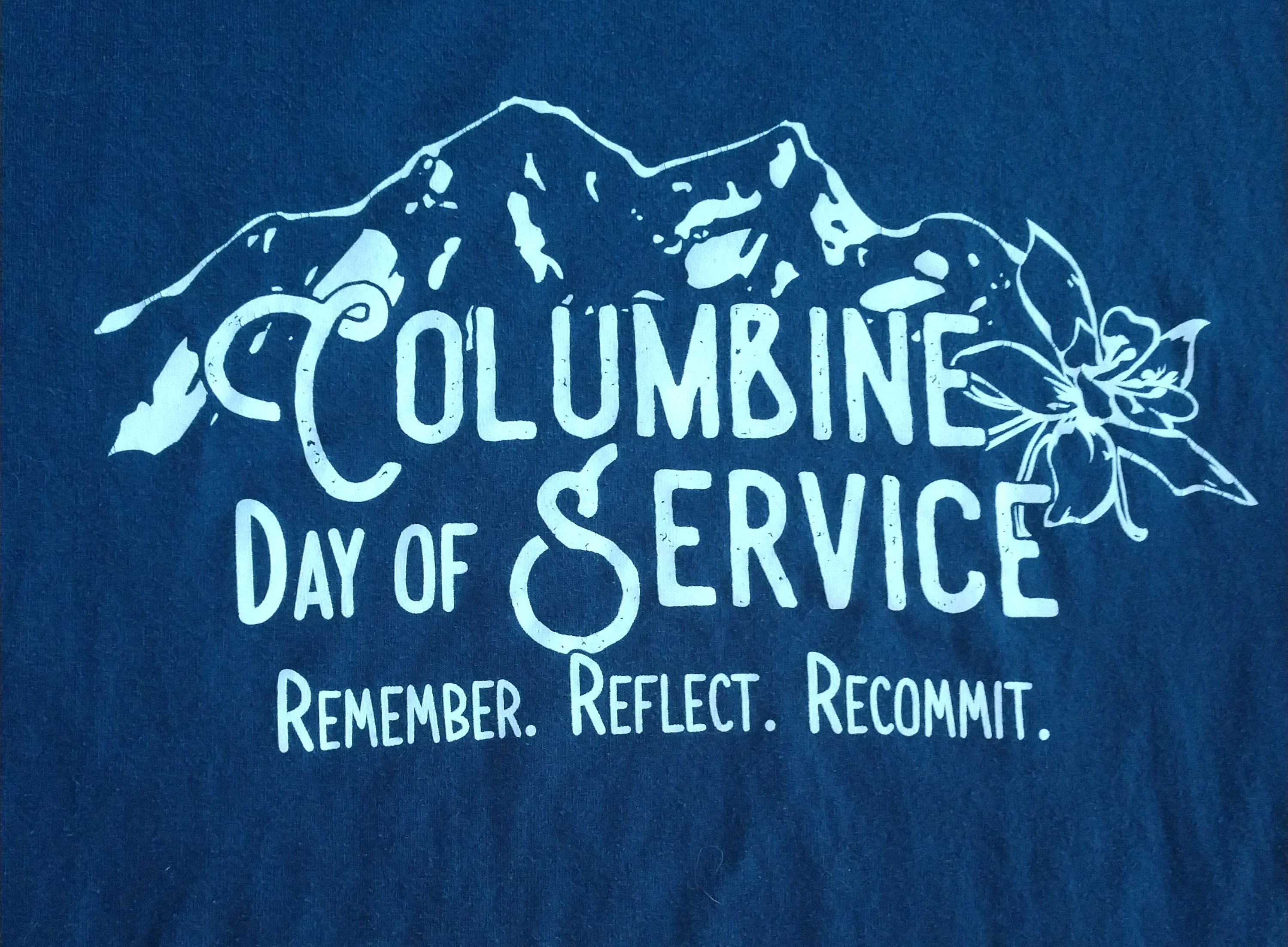
Story
Memorialization and Place at Columbine High School
The history of how a community processed its memories of the most famous school shooting in United States history, as told by a former student who was surrounded by those memories every day.
“WE ARE?”
“COLUMBINE!”
This call and response chant is regularly heard at Columbine High School. It speaks to a proud and strong shared identity, and celebrates the school’s place in its community. However, the students and staff who regularly chant those words can’t do so without acknowledging the school’s tragic history, which made it a household name across the country.
On April 20, 1999, Columbine High School became infamous across the United States as the site of the then-largest school shooting in history. The Columbine shooting was one of the first attacks on a public school to be aired on national news, especially with live coverage. Many in the country are still familiar with the events of that day. The attack began on the lower level of the school in the cafeteria, where the two shooters, Eric Harris and Dylan Klebold, initially entered the building. They continued up to the second floor of the school and into the library, where most of the violence took place. By the time the shooting ended with the deaths of the perpetrators, twelve students and one teacher had been killed.
The school's identity has become inseparable from the reality of this tragedy, and as a result memorialization has long been a concern for its community. Finding a balance between its function as a high school and the need for memorialization has been a long process, which began in the immediate aftermath and continues through the present day. Shortly after the tragedy, various groups came together to discuss memorialization. They included the parents of victims, the staff and faculty at Columbine, student survivors, and the community at large.
The Columbine Memorial Committee was founded in June 1999. The decisions they made over the following months and years embedded the history of this tragedy, and the community’s response, into the environment of the school. Some of the emotional processes are expressed through this process and its results, creating a unique environmental history which can still be read today. Decisions about what is erased, what is highlighted, and what is desired for the future all reflect on the individuals and groups involved in the aftermath of a tragedy and their thoughts, beliefs, values, and needs.

Exterior of the Hope Columbine Memorial Library, which replaced the school's original library after its demolition.
Today, around 1,700 students attend the school. I was one of them, from 2016 to 2020, and to me this tragedy was always present. Despite efforts to cleanse Columbine High School of this violence, locating the subtle presence of these memories in its environment is a reminder of the importance of turning tragedy into action.
Erasure
In the aftermath of the shooting, the community around Columbine High School faced many difficult questions. One was what to memorialize, and what to erase.
This was a conversation that involved community members, school staff, parents, and students. Discussions about erasure focused on the idea of removing buildings or spaces associated with the tragedy, which then led to debates over whether or not that erasure would be healing for the community. This discussion has lasted from the immediate aftermath of the shooting through the twentieth anniversary and is likely to continue into the future. Ultimately, the school has taken on the difficult challenge of balancing a desire for major changes, while preventing a complete erasure. This involves taking into account a variety of concerns, including denying the shooters any symbolic victory, and keeping the school functional as a place of learning.
Jeff Garkow, a Columbine student from 2002 to 2006 and currently a teacher there, remembers, “There were conversations right after the shooting. Like, should Columbine be demolished?” Others suggested that instead of demolishing the school, changing its name would help distance the school and the tragedy. In turn, this would hopefully discourage additional unwanted attention on the facility. Garkow recalls that neither the idea of changing the name of the school nor razing it entirely were very popular. These options felt too much like “let[ting] the shooters win” and “giving them a victory”, while Columbine would “cease to exist,” as Garkow puts it.
While community resistance to the complete demolition of the school remained strong, specific spaces were treated differently. As one of the main sites of violence, the library became central to conversations of erasure. The decision to demolish it was largely made by the parents of the victims and supported by staff such as Principal DeAngelis, which frustrated some students. They felt that their own input was not taken into consideration, despite earlier promises. A newspaper article at the time quotes Columbine sophomore Renee Kinsella as “wish[ing] there was some way to have the old library back.”
Cris Welsh, currently a teacher at Columbine, was a student at the time and remembered feeling some conflict between the parents and the students“[We were] told [we] would have a say. And then that vote never happened.” The survivors were the ones who would be returning to the building and using any library in the school, and many of them felt that their input was not given the weight it deserved. However, others saw this as the right decision to make out of respect for the parents. Tom Tonelli, who taught at Columbine during the shooting, was “glad that the parents took the lead” and described the decision as the parents finding it “necessary to do everything [they could] so that no kid ever has to go back into that library.”
The need to keep the school operational also limited the extent to which spaces could be erased or changed within the building. The school still needed a library, and the Hope Columbine Memorial Library was quickly built to replace the original. The goal was not just erase a site of tragedy and violence, but to create a space to recommit the high school as a place of education.

The Columbine Memorial in Clement Park is built into its surrounding hills, making it largely invisible from other areas of the park.
However, while it is called a memorial and has a large gray stone by the library doors inscribed with the names of the thirteen victims, to most students it is primarily just an ordinary high school library. As a student, I only noticed the memorial stone the first few times I visited the library as a freshman. After that, it quickly blended into the background. The library was just the place to go for books, study rooms, and printers. We never referred to the library as a memorial, and it was never introduced to us as one. The name was written on the outside of the library, but the briefest acknowledgments of its name was the most I ever engaged with it as a part of the school’s tragic history. The needs of school operations came before the need to memorialize.
The earlier debates about demolishing the entire school building were revived in 2019 with the twentieth anniversary of the shooting. This time, the chief concern was security. Jefferson County Public Schools Superintendent Jason Glass wrote an open letter to the community in 2019 about the possibility of razing the school, in which he referenced “the number of people trying to enter the school illegally or otherwise trespassing on school property” increasing to “record levels” in the months leading up to the twentieth anniversary.
The community at large, both around Columbine and across Colorado, generally resisted this suggestion to rebuild the school. In a response to Dr. Glass’ letter, community member Bobby Davis wrote that it would benefit only “the Columbine Shooters who wanted some gratification and recognition for what they did” and that “tearing down the building is a win for them.” Elizabeth Schneider, another community member, referenced the community’s pride in “reclaiming our school after the shooting” and “not allowing the shooters the satisfaction of destroying us”, echoing the sentiment of denying a symbolic victory to the shooters. These community members saw erasure as a force of more harm than good. To destroy the school was to let the shooters win, either in 1999 or in 2019.
However, there are still practical concerns regarding rebuilding. The current Columbine High School was built in 1973, which brings with it many practical issues that could be addressed by a new building. As Tonelli explained it, “If I came to you and said, I’m going to tear down your $500,000 house and build you a $3 million house, do you want to do that? And I would be like, absolutely. And that doesn’t mean I don’t love the house that I’m in right now and have a lot of great memories of that house, but I’ll [still] have the memories and I can have a more functional home.”
There is a common sense of frustration and regret among the teachers over how this proposal was handled. Instead of highlighting these structural issues in the building and the detriment it has on students, the focus on the security concerns took the conversation in a different direction. It became a debate about erasure and security rather than an opportunity to improve a building that was over forty years old, to the benefit of staff, students, and the whole community.
Visibility and Access
The location of memorials can convey a message about a tragedy, and the community’s understanding of their history. Memorials of the Columbine shooting are generally unobtrusive and occasionally inaccessible, so while they preserve this history they also emphasize the school’s functionality over a need to memorialize.
Memorials inside the school can only be seen by the small group of people who work for the school district or attend classes there. While the name of the Hope Columbine Memorial Library is displayed on the outside of the building, it can only be reached through the school and is of course inaccessible to the public.
Throughout the school, there are decorated ceramic tiles on the walls or pillars of several halls. These tiles are painted with various designs with no explanation for their creation or their placement, but they are memorials as well. After the tragedy, survivors were given the opportunity to paint a tile before returning to the building of Columbine. This method of memorialization is more individualized than any of the other forms of memorialization for Columbine, but was still limited by the function of the school.

The Wall of Healing is the outer wall of the Columbine Memorial in Clement Park. The wall features the words of survivors, bringing their story to the memorial.
A court case over the separation of church and state involving these tiles reached the Colorado Supreme Court. As Tom Tonelli explained it, survivors who included religious images on their tiles were not able to have their tiles displayed around the school with the others. Mandy Cooke, a current teacher at Columbine and a student in 1999, remembers that “the rest of the tiles” couldn’t be put up around the school, leading to a “very fragmented” display. She explained that the disjointedness of this memorial is what ultimately led to the decision to take down the tiles in the hallways, though the ones on the pillars remains. The tiles, along with the library, represent a tension between the public and private nature of memorialization which comes to a head in a space like a high school.
A public memorial of any sort on school grounds would draw in too many visitors, and be impractical for the school. These concerns were a primary consideration of the Columbine Memorial Committee, whose goal was to provide a place near enough to the school to be accessible, but distant enough so that visitors wouldn’t disrupt school activities. Mandy Cooke was one of the few students who joined the committee in 1999 and the only one to remain through the completion of the memorial in 2007. She remembers this debate over a memorial’s location, which spanned years. Cooke remembers how the possibility of building the memorial somewhere even further away, such as near Red Rocks Amphitheater, was dismissed as being too disconnected from the school. As Jeff Garkow describes it, many people found it important to have the memorial “in a place where it’s close enough to the school that people can still have a connection to that place and still feel like that presence is there with Columbine.”
The committee ultimately decided to put the memorial in nearby Clement Park, in a location that is, by design, out of the way in the large park, where it can be present without dominating the space.
However, this balance came to be expressed through a memorial that can be difficult to find without knowing exactly what to look for. While there are signs to direct visitors to the memorial, they are small and difficult to spot. As a result, many cannot find it on their own and need to be directed.
Part of this lack of visibility is due to the design of the memorial itself being closely tied to the natural environment. The memorial is surrounded by hills on three sides, and blends in as another hill in the park rather than being recognizable as an artificial structure, minimizing its presence. Once within the memorial, there are two sections. The Ring of Remembrance in the center of the memorial is dedicated to the thirteen victims, while the outer Wall of Healing is dedicated to the survivors. This wall includes anonymous quots from students and other survivors, adding their experiences into the memorial. This was a very purposeful design decision, which a placard explains “would serve to honor those innocent victims but also provide a historic record of this tragedy and to deliver a message of hope for many generations to come”
This statement allows the community to shape a narrative about the tragedy, while also moving away from it as the sole narrative of their collective history. Keeping a memorial separated and hidden away can be a way “honor the victims but without letting the tragedy overshadow the future,” as historian Kenneth Foote writes.
An Active Future
As time passes and communities gain distance from a tragedy, memorialization changes. Over twenty years have passed since the shooting, and the evolving culture of Columbine High School increasingly emphasizes a positive and service-based reinterpretation. The ongoing Day of Service project, which emphasized community service and has grown far beyond Columbine High School.
Jeff Garkow, one of the organizers of the Day of Service, remembers that the idea came from conversations about having classes on April 20th—something which hasn’t happened at Columbine High School since 1999. For Mandy Cooke and many other teachers, this was a source of frustration. Not having class left many feeling that they were stuck with their thoughts rather than being able to be productive or connect with students. According to Cris Welsh, many students had nothing to do except “sitting at home and dwelling or getting upset.”

The 2019 Columbine Day of Service logo design, including the motto “Remember. Reflect. Recommit.” This logo was printed on shirts given to all students who participated in the 2019 Day of Service.
The first Day of Service was in 2017. I first participated in 2018, during my sophomore year. By then, the Day of Service had grown slightly, as more students participated and more projects were offered through the school than before. I volunteered to do some yard work for elderly residents of the Leewood neighborhood, which is adjacent to school grounds. I remembered that during the shooting, many students fled the school and ran into the neighborhood. I felt like this project gave me the opportunity to gave back to that community in a unique way.
The Day of Service was fully realized in 2019 with over one thousand Columbine students participating in a volunteer project. That same year, Governor Jared Polis designated April 20 as a Colorado Day of Recommitment. An overwhelming majority of students sign up for Day of Service projects each year, and many alumni carry these projects on with them into their futures.
“It helps the kids refocus and realize that they’re part of a special community, and that special community needs to be taken care of and looked after,” said Welsh. It is primarily the involvement of the students that shapes what the Day of Service is, a responsibility that sustains the memorialization of Columbine for those who were not alive during, or directly impacted by, the tragedy.
As the Day of Service expands beyond the immediate community, it has helped reframe the narrative of Columbine to the world. The name “Columbine” has become synonymous with the shooting, showing how much people associate the school with the tragedy and nothing else. The Day of Service provides an opportunity to offer a different narrative about Columbine High School.
As Garkow explained, every continent other than Antarctica has participated in the Day of Service, including alumni, those with personal ties to the tragedy, and, increasingly, those without any direct connections to Columbine at all.
Still, public interest in Columbine appears to be decreasing. Jeff Garkow suggested that “maybe people are over it, a little bit,” perhaps allowing Columbine to be, in his words, “just a school now.” Cris Welsh notices a similar trend, saying that uninvited visitors to the school are “not as frequent as [they] used to be” and that there’s fewer of them every year.
Columbine High School remains focused on being a place of education for its students rather than memorialization, but it also cannot disregard the history of tragedy present within the school. Some teachers, including Garkow, have raised the question of what role current students, who were not yet born when the shooting occurred, have within these processes of memorialization that seem inseparable from the school. As the nation begins to move on from Columbine High School and the students attending the school do not personally remember the tragedy, the role of its memorials shifts again.
The focus on the future shown by both the physical memorials and the Day of Service allows the staff, students, and community of Columbine High School to channel a tragic past into something constructive. As time passes and people are less interested in Columbine as a space of tragedy, this commitment to positivity and the school as a place of education can become the sole priority of the school’s memorialization. Embedding the tragedy into the built and natural environment allows this future focus and enables a process of understanding, healing, and recommitment, rather than solely one of remembrance and grieving.
